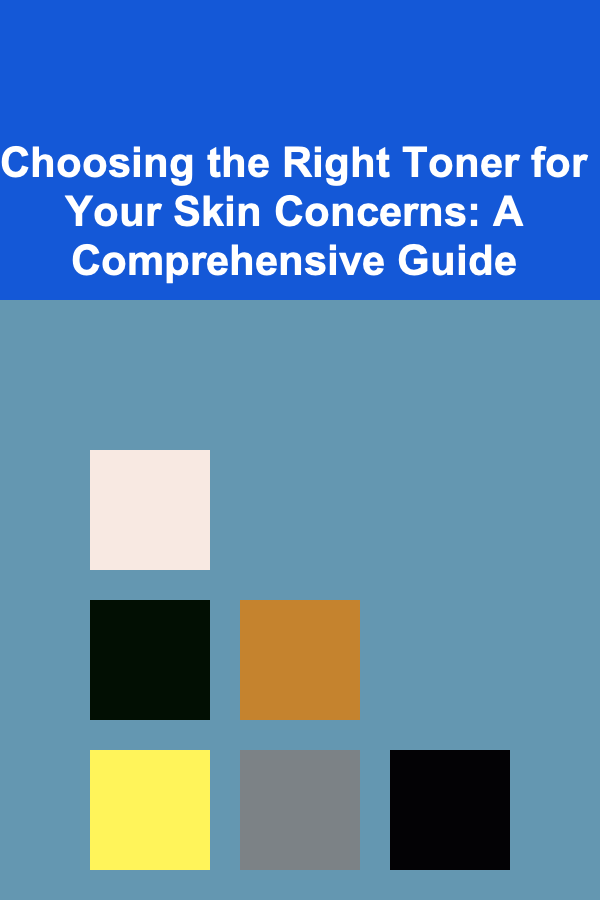
Choosing the Right Toner for Your Skin Concerns: A Comprehensive Guide
ebook include PDF & Audio bundle (Micro Guide)
$12.99$7.99
Limited Time Offer! Order within the next:

Toners often get overlooked in the skincare routine, sometimes considered an unnecessary step. However, the right toner can be a game-changer, addressing specific skin concerns and preparing your skin for better absorption of subsequent products. This comprehensive guide will delve into the world of toners, exploring their purpose, different types, ingredients to look for, and how to select the perfect toner tailored to your individual skin needs. We'll also explore common mistakes and provide expert tips for maximizing the benefits of this often-misunderstood skincare staple.
Understanding the Purpose of Toner
Historically, toners were used to balance the skin's pH after cleansing with harsh, alkaline soaps. Modern cleansers are generally pH-balanced, but toners have evolved to offer a multitude of benefits beyond simple pH adjustment. The primary functions of a toner include:
- Balancing Skin's pH: Restoring the skin's optimal pH level (around 5.5) after cleansing, creating an ideal environment for healthy skin function.
- Removing Residual Impurities: Eliminating any remaining dirt, oil, and makeup that your cleanser might have missed.
- Hydration: Many toners contain hydrating ingredients to replenish moisture and prevent dryness.
- Preparing Skin for Serums and Moisturizers: By hydrating and slightly exfoliating the skin, toners enhance the absorption and effectiveness of subsequent skincare products.
- Targeting Specific Skin Concerns: Toners can be formulated with ingredients that address issues like acne, hyperpigmentation, sensitivity, and aging.
Decoding Toner Types: A Diverse Landscape
The toner market is saturated with a vast array of products, each boasting different ingredients and promising various benefits. Understanding the different types of toners available is crucial for making an informed decision. Here's a breakdown of the most common categories:
1. Hydrating Toners: The Moisture Boosters
Hydrating toners focus on replenishing moisture and soothing the skin. They are generally alcohol-free and contain humectants, which draw moisture from the air into the skin. These are excellent for dry, dehydrated, and sensitive skin types.
- Key Ingredients: Hyaluronic acid, glycerin, aloe vera, rosewater, ceramides, amino acids, and botanical extracts.
- Benefits: Provides immediate hydration, plumps the skin, reduces the appearance of fine lines, soothes irritation, and strengthens the skin barrier.
- Who Should Use It: Individuals with dry, dehydrated, sensitive, or mature skin. They are also beneficial in dry climates or during the winter months.
2. Exfoliating Toners: The Skin Smoothers
Exfoliating toners contain chemical exfoliants that gently remove dead skin cells, revealing a brighter, smoother complexion. They are effective for improving skin texture, reducing breakouts, and minimizing the appearance of pores.
- Key Ingredients: Alpha hydroxy acids (AHAs) like glycolic acid and lactic acid, beta hydroxy acids (BHAs) like salicylic acid, and polyhydroxy acids (PHAs) like gluconolactone.
- Benefits: Exfoliates dead skin cells, unclogs pores, reduces blackheads and whiteheads, brightens skin tone, improves skin texture, and promotes cell turnover.
- Who Should Use It: Individuals with oily, acne-prone, or combination skin. Those with dull skin or uneven texture can also benefit. Use with caution if you have sensitive skin and always start with a low concentration.
3. Balancing Toners: The pH Harmonizers
These toners are designed to restore the skin's natural pH balance after cleansing. While modern cleansers are typically pH-balanced, these toners can still provide additional benefits like hydration and soothing properties. Many so-called "pH balancing" toners today are actually light hydrating toners.
- Key Ingredients: Rosewater, aloe vera, glycerin, and mild astringents.
- Benefits: Restores skin's pH balance, soothes irritation, and preps skin for further treatment.
- Who Should Use It: Suitable for most skin types, especially those who want a gentle, hydrating toner.
4. Astringent Toners: The Oil Controllers
Astringent toners contain alcohol or other ingredients that tighten pores and reduce oil production. These are often marketed for oily and acne-prone skin, but they can be harsh and drying, especially if used excessively.
- Key Ingredients: Alcohol (denatured alcohol, isopropyl alcohol), witch hazel, and salicylic acid (in higher concentrations).
- Benefits: Removes excess oil, tightens pores (temporarily), and can help to dry out blemishes.
- Who Should Use It: Primarily for very oily skin. However, many experts recommend avoiding alcohol-based astringents altogether due to their potential to strip the skin of its natural oils and lead to irritation. If you choose to use one, opt for an alcohol-free astringent with ingredients like witch hazel, and use it sparingly.
5. Treatment Toners: The Targeted Solutions
These toners are formulated with specific active ingredients to address particular skin concerns, such as acne, hyperpigmentation, or signs of aging. They are essentially liquid serums delivered in a toner format.
- Key Ingredients: Niacinamide, vitamin C, retinol, peptides, and antioxidants.
- Benefits: Targets specific skin concerns like acne, hyperpigmentation, fine lines, and wrinkles. Provides antioxidant protection and promotes collagen production.
- Who Should Use It: Individuals with specific skin concerns that require targeted treatment. Choose a toner with ingredients that address your individual needs.
Ingredient Spotlight: Navigating the Toner Label
Understanding the ingredients list is crucial for selecting the right toner. Here's a closer look at some key ingredients and their benefits:
- Hyaluronic Acid: A powerful humectant that attracts and retains moisture in the skin.
- Glycerin: Another effective humectant that draws moisture from the air into the skin.
- Aloe Vera: A soothing and hydrating ingredient with anti-inflammatory properties.
- Rosewater: A gentle and hydrating ingredient with calming and anti-inflammatory benefits.
- Ceramides: Lipids that help to strengthen the skin barrier and prevent moisture loss.
- Amino Acids: Building blocks of proteins that help to hydrate and repair the skin.
- Glycolic Acid: An AHA that exfoliates dead skin cells and improves skin texture.
- Lactic Acid: A milder AHA that exfoliates and hydrates the skin.
- Salicylic Acid: A BHA that penetrates pores to unclog them and reduce breakouts.
- Gluconolactone: A PHA that exfoliates gently and provides antioxidant benefits.
- Niacinamide: A form of vitamin B3 that brightens skin, reduces inflammation, and minimizes pores.
- Vitamin C: An antioxidant that protects against free radical damage and brightens skin tone.
- Retinol: A form of vitamin A that promotes cell turnover and reduces the appearance of fine lines and wrinkles. (Often found in serum format, but occasionally in a toner.)
- Peptides: Amino acid chains that help to stimulate collagen production and improve skin elasticity.
- Antioxidants: Protect the skin from free radical damage caused by environmental factors. Examples include green tea extract, vitamin E, and resveratrol.
Choosing the Right Toner for Your Skin Type and Concerns
Now that you understand the different types of toners and key ingredients, let's discuss how to choose the right toner for your specific skin type and concerns:
1. For Dry Skin: Focus on Hydration and Soothing
- Look for: Hydrating toners with hyaluronic acid, glycerin, aloe vera, rosewater, ceramides, and amino acids.
- Avoid: Alcohol-based toners and those with harsh exfoliants.
- Recommended Products: Toners specifically labeled as "hydrating," "soothing," or "for dry skin."
2. For Oily Skin: Control Oil and Minimize Pores
- Look for: Exfoliating toners with salicylic acid (BHA) or glycolic acid (AHA) to unclog pores and control oil production. Witch hazel in an alcohol-free formula can be a mild astringent.
- Avoid: Toners with heavy oils or ingredients that can clog pores. High concentrations of alcohol can be irritating.
- Recommended Products: Toners labeled as "oil-controlling," "pore-minimizing," or "for oily skin."
3. For Combination Skin: Balance Hydration and Exfoliation
- Look for: Toners that offer a balance of hydration and exfoliation. Consider using different toners on different areas of your face (e.g., a hydrating toner on dry areas and an exfoliating toner on oily areas).
- Avoid: Harsh astringents that can dry out the skin and excessively rich toners that can clog pores in oily areas.
- Recommended Products: Toners labeled as "for combination skin" or those with a blend of hydrating and exfoliating ingredients. You can also use different toners in different zones of your face.
4. For Acne-Prone Skin: Target Breakouts and Reduce Inflammation
- Look for: Toners with salicylic acid (BHA) to unclog pores and reduce inflammation. Niacinamide can also help to reduce redness and inflammation. Tea tree oil is another effective ingredient for fighting acne-causing bacteria.
- Avoid: Toners with fragrances, dyes, and harsh alcohols that can irritate the skin and worsen breakouts.
- Recommended Products: Toners labeled as "for acne-prone skin" or those with acne-fighting ingredients. Start with a low concentration of active ingredients to avoid irritation.
5. For Sensitive Skin: Soothe and Protect
- Look for: Toners that are fragrance-free, alcohol-free, and hypoallergenic. Look for ingredients like aloe vera, rosewater, chamomile, and green tea extract, which have soothing and anti-inflammatory properties.
- Avoid: Toners with harsh exfoliants, alcohol, fragrances, dyes, and essential oils, which can irritate sensitive skin.
- Recommended Products: Toners specifically labeled as "for sensitive skin" or those with calming and soothing ingredients. Always patch test before applying to your entire face.
6. For Mature Skin: Hydrate, Firm, and Brighten
- Look for: Hydrating toners with hyaluronic acid, peptides, and antioxidants. Toners with mild exfoliants (AHAs or PHAs) can help to improve skin texture and brightness.
- Avoid: Toners with harsh alcohols that can dry out the skin and exacerbate wrinkles.
- Recommended Products: Toners labeled as "anti-aging," "firming," or "for mature skin." Look for ingredients like retinol (use with caution and always use sunscreen), vitamin C, and peptides.
7. For Hyperpigmentation: Brighten and Even Skin Tone
- Look for: Toners with ingredients like vitamin C, niacinamide, and AHAs (glycolic acid, lactic acid) to brighten skin tone and fade dark spots.
- Avoid: Toners that are irritating or drying, as inflammation can worsen hyperpigmentation. Always use sunscreen during the day.
- Recommended Products: Toners labeled as "brightening" or "for hyperpigmentation." Remember that consistency and sun protection are key to seeing results.
How to Use Toner Correctly: Maximizing the Benefits
Using toner correctly is essential for reaping its full benefits. Follow these steps for optimal results:
- Cleanse Your Skin: Start with a gentle cleanser to remove dirt, oil, and makeup.
- Apply Toner: Apply a small amount of toner to a cotton pad or directly into your hands. Gently pat or swipe the toner over your face and neck, avoiding the eye area.
- Wait for Absorption: Allow the toner to absorb into your skin for a few seconds before applying your serum or moisturizer.
- Follow with Serum and Moisturizer: Complete your skincare routine with a serum and moisturizer appropriate for your skin type.
Tips for Best Results:
- Use Toner Twice Daily: Apply toner in the morning and evening after cleansing.
- Patch Test New Toners: Always patch test a new toner on a small area of your skin before applying it to your entire face to check for any allergic reactions or irritation.
- Adjust Frequency as Needed: If you experience dryness or irritation, reduce the frequency of use or switch to a more hydrating toner. If you're using an exfoliating toner, start with 2-3 times per week and gradually increase as tolerated.
- Don't Over-Exfoliate: Be careful not to over-exfoliate your skin, as this can lead to irritation and dryness. Avoid using multiple exfoliating products at the same time.
- Be Patient: It may take several weeks to see noticeable results from using a new toner. Be patient and consistent with your skincare routine.
Common Mistakes to Avoid When Choosing and Using Toner
Here are some common mistakes to avoid when choosing and using toner:
- Choosing a Toner Based on Hype: Don't blindly follow trends or recommendations without considering your own skin type and concerns.
- Using the Wrong Toner for Your Skin Type: Using a toner that is not suitable for your skin type can lead to dryness, irritation, or breakouts.
- Using Too Much Toner: Using too much toner can strip the skin of its natural oils and lead to dryness.
- Not Patch Testing New Toners: Failing to patch test new toners can result in allergic reactions or irritation.
- Over-Exfoliating: Over-exfoliating can damage the skin barrier and lead to sensitivity and irritation.
- Ignoring the Ingredients List: Not paying attention to the ingredients list can lead to using products with potentially harmful or irritating ingredients.
- Not Using Sunscreen: Using exfoliating toners can increase your skin's sensitivity to the sun. Always use sunscreen during the day to protect your skin from damage.
- Thinking Toner is a Replacement for Cleansing: Toner is not a replacement for cleansing. It's designed to be used after cleansing to remove residual impurities and prepare the skin for subsequent products.
The Future of Toner: Innovation and Customization
The future of toner is likely to involve even more personalized and innovative formulations. We can expect to see:
- Customized Toners: Toners tailored to individual skin needs based on factors like genetics, lifestyle, and environmental exposure.
- Microbiome-Friendly Toners: Toners formulated to support a healthy skin microbiome.
- Sustainable and Eco-Friendly Toners: Toners with sustainable packaging and ethically sourced ingredients.
- More Multifunctional Toners: Toners that combine multiple benefits in one product, such as hydration, exfoliation, and antioxidant protection.
Conclusion: Embrace the Power of Toner
Choosing the right toner can significantly enhance your skincare routine and address your specific skin concerns. By understanding the different types of toners, key ingredients, and how to use them correctly, you can unlock the full potential of this often-underestimated skincare product. Remember to listen to your skin, choose products that are suitable for your individual needs, and be patient with the results. With the right toner, you can achieve a healthier, brighter, and more radiant complexion.

How to Build a Deep Learning-Based SaaS Business for Passive Income
Read More
How to Maximize Your Retirement Savings with IRAs
Read More
How to Store Holiday Decorations Without the Mess
Read More
The Art Director's Playbook: Innovative Approaches to Visual Storytelling
Read More
The Best Interview Practices for Introverts: An Actionable Guide
Read More
10 Tips for Drawing with Colored Pencils: Blending Techniques
Read MoreOther Products

How to Build a Deep Learning-Based SaaS Business for Passive Income
Read More
How to Maximize Your Retirement Savings with IRAs
Read More
How to Store Holiday Decorations Without the Mess
Read More
The Art Director's Playbook: Innovative Approaches to Visual Storytelling
Read More
The Best Interview Practices for Introverts: An Actionable Guide
Read More